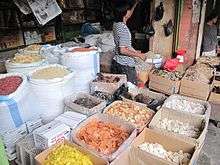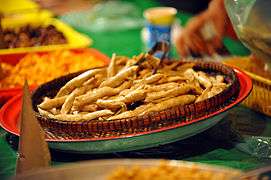Krupuk
Krupuk or kerupuk (Indonesian) or kroepoek (Dutch) is an Indonesian deep fried crackers made from starch and other ingredients that serve as flavouring. They are a popular snack in parts of Southeast Asia, but most closely associated with Indonesia.[2] Kroepoek also can be found in the Netherlands, through their historic colonial ties with Indonesia.[3]
 Krupuks in air-tight tin container | |
| Course | Snack |
|---|---|
| Place of origin | Indonesia[1] |
| Region or state | Southeast Asia |
| Associated national cuisine | Indonesia |
| Serving temperature | Room temperature |
| Main ingredients | Deep fried dried starch and other ingredients, the most popular is prawn and fish |
| Variations | Different variations according to ingredients |
 |
| This article is part of the series on |
| Indonesian cuisine Masakan Indonesia |
|---|
|
Ingredients |
|
Styles |
|
Holidays and festivals |
|
Related cuisines |
|
|
Etymology
In Indonesia, the term krupuk refers to the type of relatively large crackers, while the term kripik or keripik refers to smaller bite-size crackers; the counterpart of chips (or crisps) in western cuisine. For example, potato chips are called kripik kentang in Indonesia. Both terms, krupuk and kripik, sound like the breaking or crumbling of this crispy snack to denote its crispiness. Thus, the etymology of the term krupuk is an onomatopoeia in Indonesian to describe the crunch sound of this crispy snack.[4]
Usually krupuk is made from the dried paste from the mixture of starch with other ingredients, while kripik is usually made entirely from thinly sliced, sun-dried, and fried products without any mixture of starch.
Preparation and consumption
To achieve maximum crunchiness, most of this pre-packed raw krupuk must be sun-dried first before being deep fried at home. To cook krupuk, a wok and plenty of very hot cooking oil is needed. A healthier fatless version might be made by briefly pulsing the raw krupuk in the microwave oven: usually one minute at the medium (~700W) power is enough to successfully puff a handful of chips. Raw krupuk is quite small, hard, and darker in color than cooked one.[5]
Krupuk and kripik can be consumed alone as a snack, or cracked and sprinkled on top of certain food as a complement to add crispy texture. Certain Indonesian dishes such as gado-gado, karedok, rujak, asinan, bubur ayam and certain kinds of soto were known to require certain type of krupuk for toppings. Krupuk is an essential ingredient to make seblak, a savoury and spicy dish made of boiled wet krupuk cooked with protein sources (chicken, beef or seafood) in spicy sauce.[6]
Types
Indonesia

Indonesia has perhaps the largest variety of krupuk.[2] There are many variations on krupuk, many of which are made from starch with seafood (shrimp, fish, or squid), but occasionally with rice, fruits, nuts or vegetables; these variations are more usual in Southeast Asia.

- Krupuk amplang, refer to pingpong balls-sized fish krupuk from Kalimantan.
- Krupuk bawang, garlic cracker
- Krupuk gendar, ground rice cracker
- Krupuk ikan, fish cracker, commonly found in Indonesia, especially seafood industry production centres, such as Palembang, Bangka, Cirebon and Sidoarjo. Wahoo is the most popular fish used to make krupuk ikan, however a more expensive variant uses belida fish / featherback knifefish.
- Krupuk blek (also known as krupuk uyel, krupuk kampung, or krupuk putih), cassava starch cracker is ubiquitous in Indonesia
- Krupuk kemplang, a type of flat fish cracker is particularly popular in Southern Sumatran city of Palembang
- Krupuk kuku macan, another name of amplang with distinct "tiger nail" nugget-shaped brown-coloured fish cracker, popularly associated with Samarinda and the island of Bangka.
- Krupuk kulit (most parts of Indonesia), Krupuk jangek (Minangkabau), or Rambak (Java), refer to cracker made from dried cattle skin, particularly popular in Minangkabau area West Sumatra.
- Krupuk kulit babi, crispy fried pork skin, also known as pork rinds. Rarely found in Muslim majority regions in Indonesia, but common in non-Muslim majority provinces, such as Bali, North Sumatra, and North Sulawesi.
- Krupuk mie (noodle cracker) is yellowish krupuk made from noodle-like paste usually used for asinan topping, particularly popular in Jakarta and most of markets in Java.
- Krupuk udang, shrimp cracker or prawn cracker probably is the most internationally well-known variant of krupuk. The examples of popular krupuk udang brands in Indonesia is Finna[7] and Komodo brand whereas the popular krupuk udang household brands in Malaysia are Rota Prawn Crackers and myReal Pulau Pangkor Prawn Crackers.[8]
- Krupuk udang, prawn cracker
- Krupuk ikan, fish cracker
 Kerupuk kampung made of tapioca starch
Kerupuk kampung made of tapioca starch- Krupuk amplang, fish cracker
- Krupuk kemplang, fish cracker
- Krupuk mie, noodle cracker
- Krupuk kulit, skin cracker
Malaysia

In Malaysia, it is called as keropok and associated with fish and seafood (other then fish and seafood are called kerepek). 3 type of keropok in Malaysia is Keropok kering, Keropok lekor and amplang. Keropok Lekor, originated from Terengganu and Amplang from the coastal towns of Semporna and Tawau in Sabah which is also can be found in Kalimantan. While keropok kering can be found in most of Malaysia states [9] Mukah town in Sarawak also historically known as a fishing town for the making of Keropok.[10]
There are varieties of keropok lekor, amplang and keropok kering in Malaysia.
Philippines
Krupuk, is most commonly known as 'kropek' and 'kropeck' in the Philippines, but is sometimes also referred to as 'fish crackers', 'prawn crackers' or less commonly as 'fish chicharron', which is technically fried fish skin. But in the Philippines some forms of chicharron are not made with animal products at all, rather they are made with tapioca starch and green peas, hence the term 'fish chicharron' came to be. It's debatable if the vegetarian, kropek like 'mock pork cracklin' could be considered a form of kropek, since there are a lot of similarities but also differences which make them two, be it separate, but comparable snacks. They are sold at sari-sari stores in smaller portions, suitable for kids or people who are looking for a light snack, as well as in bigger bags at local supermarkets and convenience stores.
Kropek is eaten as an appetizer, with a vinegar and chili dipping sauce, sometimes as accompaniment at drinking sessions, or paired with a meal. There are a lot of local brands which sell 'kropek' all with their own touch. However, some of the most popular and well known brands in the Philippines are the 'La La Fish Crackers' and Oishi renowned for their prawn crackers, fish crackers and fish kropeck. Oishi, being a Philippines-based company, which has expanded all across Asia, making it not only one of the biggest Filipino brands, but one of the biggest Asian companies.
Other similar crackers
These are similar crackers, however commonly not considered as krupuk.
- Emping is a type of cracker made from melinjo (Gnetum gnemon) nuts.
- Rempeyek is another flour-based cracker with brittle of peanuts, anchovies or shrimp bound by crispy flour cracker.
- Rengginang or intip (Javanese) is a rice cracker made from sun-dried and deep fried leftover rice.
- Kripik or keripik refers to smaller bite-size crackers; the counterpart of chips (or crisps).
- Kappa Ebisen is a Japanese snack food based on Krupuk produced by Calbee in Japan from 1964.
Production centres
In Indonesia, major producing centres of krupuk usually are coastal fishing towns. Sidoarjo in East Java,[11] Cirebon and Garut in West Java, Karimun Jawa island, Padang, Palembang and Medan in Sumatra, Bangka Island, Samarinda and Pontianak in Kalimantan, and Makassar in Sulawesi are major producers of krupuk, and many recipes originate from there.
Most of the coastal towns in Malaysia such as Mukah, Malacca Town, Pangkor Island and Lumut produce keropok from large scale manufacturing to small scale home factories.
See also
Notes
References
- Adrian Vickers (3 November 2005). A History of Modern Indonesia. Cambridge University Press. pp. 190–. ISBN 978-1-139-44761-4.
- Yohan Handoyo. "Christmas Crackers". Jakarta Java kini. Archived from the original on 7 April 2014. Retrieved 4 April 2014.
- "A Guide to Dutch Indonesian Cuisine". Awesome Amsterdam. Archived from the original on 6 July 2014. Retrieved 15 August 2014.
- Kompasiana.com. "Onomatopoeia, Dari Kuping Turun ke Lidah oleh Gustaaf Kusno - Kompasiana.com". kompasiana.com (in Indonesian). Retrieved 29 January 2018.
- Indonesian Regional Food and Cookery: Prawn cracker
- Karina Armadani (19 December 2014). "Kuliner Tradisional: Menikmati Pedasnya Seblak Khas Bandung". CNN Indonesia (in Indonesian).
- Krupuk Udang Finna
- "myReal Pulau Pangkor Prawn Crackers by Lumut Crackers Sdn. Bhd". lumutcrackers.com.my.
- Su-Lyn Tan; Mark Tay (2003). Malaysia & Singapore. Lonely Planet. pp. 149–. ISBN 978-1-74059-370-0.
- Pat Foh Chang (1999). Legends and history of Sarawak. Chang Pat Foh. ISBN 978-983-9475-07-4.
- "Sidoarjo Cracker Industry". EastJava.com. 4 November 2010. Retrieved 3 November 2014.